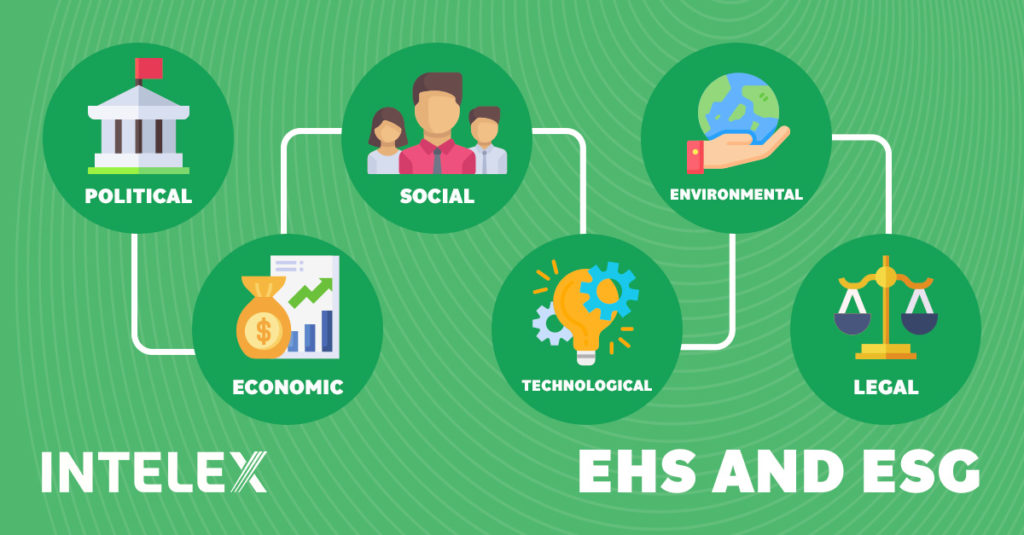5 Ways EHS Professionals Can Support ESG Initiatives
June 23, 2022

A move by organizations everywhere to adopt environmental, social and corporate governance (ESG) criteria could be today’s primary catalyst in transforming the future role of the environment, health and safety (EHS) profession.
ESG issues have taken on an increased sense of urgency for businesses around the world as public opinion becomes sensitive to social and environmental issues. Regulatory changes are expected to set the jumping off point for organizations, and investors and companies will need to have strong frameworks for identifying ESG risks with overall mechanisms and tracking capabilities as part of their management systems.
During an Intelex-sponsored EHS Today webinar in June discussing how safety professionals can support ESG initiatives, Ashley Gill, regional safety manager for Valicor Environmental Services, said there traditionally has been a disconnect between EHS professionals and business leadership. Safety practitioners are often seen as technical specialists or even generalists and are not typically involved in discussions that surround business goals and opportunities. But that perception is about to change.
“As a result of corporate ESG framework requirements, (EHS professionals) are getting opportunities to be real business partners,” she says, adding their vast experience in managing risk perfectly aligns with many ESG initiatives. “I am confident companies will not have good ESG without good EHS because of how EHS components intersect and overlap with ESG. It’s been our job (as safety professionals) to exceed compliance standards and keep risk at bay.” That will help to drive ESG success.
Environment is perhaps the most clear-cut intersection, according to Gill. She expects the metrics used to measure and report EHS risk – including those for greenhouse gas (GHG) emissions, energy and water conservation, waste management, water quality, pollution and environmental compliance – will be part of ESG reporting.
EHS professionals also deal with employee relations, training and education, privacy and security plus general employee health and wellbeing on a regular basis and these concerns impact local communities and are part of occupational health and safety and support the social pillar of ESG, Gill says.
Procurement practices, supply chain administration and advanced risk management are areas where some EHS professionals will see an intersection and overlap in various corporate governance practices – another area of ESG.
So where should EHS professionals focus their efforts to best support the ESG initiatives of their organizations? Gill suggests these five areas.
Breaking Down Corporate Silos
The role of EHS professionals encompass cross-functional work and functions. They also routinely interact with many business groups, which makes them qualified to support development of workflows through interconnections with people. Gill believes EHS professionals are well positioned to be change agents within organizations, assuming there is leadership willingness for that to happen. EHS professionals have strengths as communicators and should be able to successfully support necessary organizational change through conversations with front-line workers.
EHS professionals can also help by understanding the “innovators dilemma,” where a lack of participation based on fear of “innovating themselves out of a job” may be apparent, she says, adding, “As EHS professionals, we need to be able to assuage some of those fears.”
EHS leaders must also expand their perception of what sustainability is and how it aligns to EHS. Simply mitigating environmental concerns is no longer sufficient.
“We need to view sustainability as a growth tool (for the business) that will allow us to create value through results like waste reduction and improved process efficiency,” she says. That will encourage those who view EHS as simply compliance to instead consider the greater business value it can provide.
ESG and EHS Education
EHS professionals play an important part in driving broader understanding of how their company’s operations impact communities, particularly in two areas – GHS and per-and polyfluoroalkyl substances (PFAS).
“We have to think about educating the community beyond our fence line about what the company does,” Gill says.
She expects more organizations will voluntarily align with ESG concerns and those that do will need to educate their employees on ESG standards so that they understand how their company operates within that voluntary framework, Gill says.
Gill believes safety monitoring, which has been a regulatory driven and reported data management exercise for EHS, will need to be used to educate stakeholders, such as investors who want to see these results and understand their community impact.
Soft Skills to Advance Worker Health and Safety
People, social and interpersonal skills applied by EHS professionals to health and safety must extend to encompass human rights and total worker health and include stakeholders such as those in supply chains, contractors, clients, investors and communities.
“We need to be able to take those things into consideration,” Gill says, explaining EHS professionals must continually display ethical leadership, adaptability, problem solving and teamwork. “Just as we lead by example by wearing proper PPE in a plant, we’ll need to do the same with people skills because, at the end of the day, culture eats strategy for breakfast.”
EHS professionals must understand total worker health and the responsibility organizations have in creating “psychologically safe” cultures that “maximize the contributions of its talent” by ensuring people are physically and mentally safe to be at work and deliver their best work, she says.
Goal Setting for ESG Success
Many companies are just beginning their ESG journey and may not know where to start, while others that have started perhaps hit a stumbling block and not know what to do next.
“To this I say, have no fear. I think EHS professionals can help,” Gill says, adding they have a thorough understanding of how compliance should be applied in real life situations and understand the risk profile of their organizations. Both are starting points for establishing the basic components of a solid ESG foundation.
“EHS professionals can assist in establishing good program management through their experience in managing safety and environmental systems for many years,” she says. “It’s not going to be a huge lift to integrate some of those ESG-type components within traditional (EHS) management systems.”
Safety professionals need to also support a strong communication strategy.
“Communication is key. It empowers our team members in the field and our employees to do good work and make good decisions,” Gill says. “It’s something we already do as EHS professionals. We have meetings, we do training and we do audits. These are all things that we can help our management teams do as part of the foundation for setting them up for success as they pursue their ESG initiatives.”
ESG Tech-Driven Transformation
Gill calls this the No.1 consideration and a moving target because so much innovation is happening in technology today. Organizations need a better way to manage ESG compliance and that will be through technology. The days of pen, paper and worksheets are quickly becoming antiquated and, according to Gill, “technology will become the standard for how we perform our work and manage EHS/ESG compliance systems within our organizations.”
She says EHS professionals recognize their systems can do more and be used holistically. The emergence of ESG management ensures a future use for these systems, not just for EHS, but to support those who own portions of ESG initiatives. But data quality will be critical.
“Technology will bring more information and it will be important for us as EHS professionals to discern good-quality data (the things that provide value) from the bad-quality data gathered by other entities that non-regulatory stakeholders might use,” Gill says.
“There’s a lot of misinformation out there in the world and we just need to make sure that we can discern the good from the bad when it comes to data for our organizations and industries.”
Want to stay ahead in your ESG journey? Watch our on-demand webinar, What to Do Differently With Technology for ESG Success, and learn how to leverage modern ESG management tools to meet evolving disclosure requirements.






